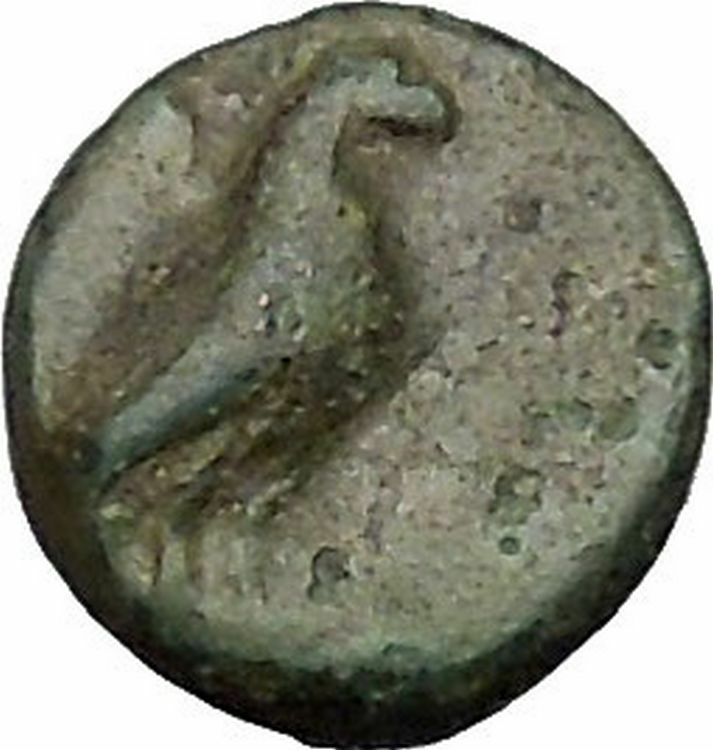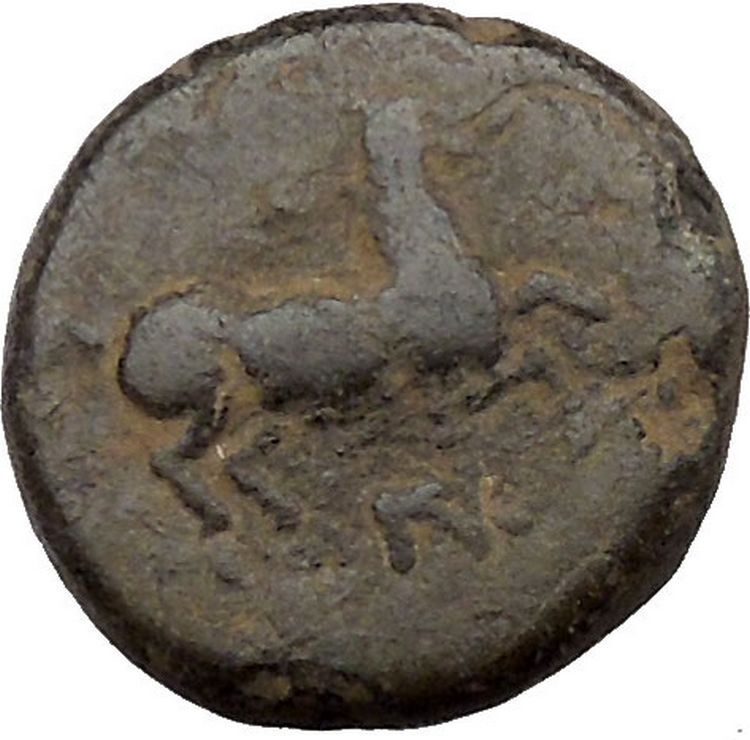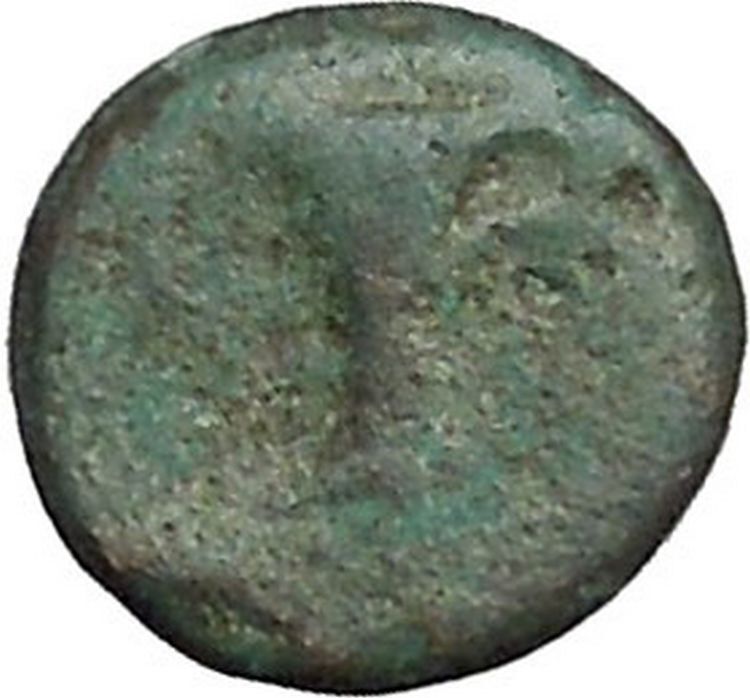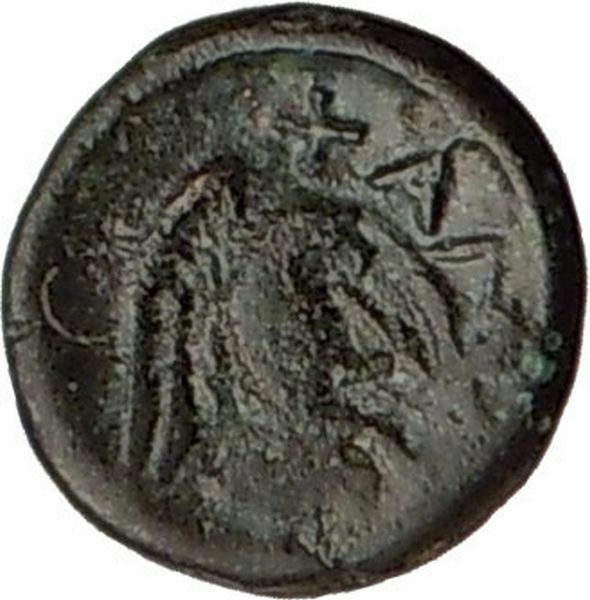|
Greek city of Neapolis in Campania
Bronze 21mm (5.25 grams) Struck 270-240 B.C.
Reference: Sear 557 var.; B.M.C. 1. 212 var.; SNG Cop 504-27 var.
NEOΠΟΛΙΤΩΝ –
Laureate head of Apollo left.
Man-headed bull walking right, head facing, crowned by Nike flying right above;
beneath bull, IΣ.
Originally a Rhodian colony of very early foundation under the
name of Parthenope, the city was recolonized by Kymaians circa 600 B.C. and its
name finally changed to Neapolis circa 450 B.C. Allied with Rome from 326 B.C.
You are bidding on the exact item pictured,
provided with a Certificate of Authenticity and Lifetime Guarantee of
Authenticity.
In
Greek mythology
,
Nike
was a goddess
who personified
victory
, also known as the Winged Goddess of
Victory. The Roman equivalent was
Victoria
. Depending upon the time of various
myths, she was described as the daughter of
Pallas
(Titan) and
Styx (Water) and the sister of
Kratos
(Strength),
Bia
(Force), and
Zelus
(Zeal). Nike and her siblings were close
companions of Zeus
, the dominant deity of the
Greek pantheon
. According to classical (later)
myth, Styx brought them to Zeus when

the
god was assembling allies for the
Titan War
against the older deities. Nike
assumed the role of the divine
charioteer
, a role in which she often is
portrayed in Classical Greek art. Nike flew around battlefields rewarding the
victors with glory and fame.
Nike is seen with wings in most statues and paintings. Most other winged
deities in the Greek pantheon had shed their wings by Classical times. Nike is
the goddess of strength, speed, and victory. Nike was a very close acquaintance
of Athena
, and is thought to have stood in
Athena’s outstretched hand in the statue of Athena located in the Parthenon.
Nike is one of the most commonly portrayed figures on Greek coins.
Names stemming from Nike include amongst others:
Nicholas
, Nicola, Nick, Nikolai, Nils, Klaas,
Nicole, Ike, Niki, Nikita, Nika, Niketas, and Nico.

Apollo Belvedere
,
ca. 120–140 CE
Apollo is one of the most important and complex of the
Olympian deities
in
ancient Greek
and
Roman religion
,
Greek
and
Roman mythology
, and
Greco
–Roman
Neopaganism
. The ideal of the
kouros
(a beardless, athletic youth),
Apollo has been variously recognized as a god of light and the sun, truth and
prophecy, healing, plague, music, poetry, and more. Apollo is the son of
Zeus and Leto
, and has a twin sister, the chaste
huntress Artemis
. Apollo is known in Greek-influenced
Etruscan mythology
as Apulu.
As the patron of Delphi
(Pythian Apollo), Apollo was an
oracular
god—the prophetic deity of the
Delphic Oracle
. Medicine and healing are
associated with Apollo, whether through the god himself or mediated through his
son Asclepius
, yet Apollo was also seen as a god
who could bring ill-health and deadly
plague
. Amongst the god’s custodial charges,
Apollo became associated with dominion over
colonists
, and as the patron defender of herds
and flocks. As the leader of the
Muses (Apollon Musegetes) and director of their choir, Apollo
functioned as the patron god of music and poetry.
Hermes
created the
lyre for him, and the instrument became a common
attribute of Apollo
. Hymns sung to Apollo were
called paeans
.
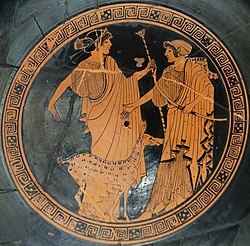
Apollo (left) and
Artemis
.
Brygos
(potter signed), Tondo of an
Attic red-figure cup c. 470 BC,
Musée du Louvre
.
In Hellenistic times, especially during the 3rd century BCE, as Apollo
Helios he became identified among Greeks with
Helios
,
Titan
god of the sun
, and his sister Artemis
similarly equated with
Selene
, Titan
goddess of the moon
In Latin texts, on the
other hand,
Joseph Fontenrose
declared himself unable to
find any conflation of Apollo with
Sol
among the
Augustan poets
of the 1st century, not even in
the conjurations of Aeneas
and
Latinus
in
Aeneid
XII (161–215). Apollo and Helios/Sol
remained separate beings in literary and mythological texts until the 3rd
century CE.
Etymology

Statuette of the Apollo Lykeios type,
Museum of the Ancient Agora of Athens
(inv. BI 236).
Apollo was worshipped throughout the
Roman Empire
. In the traditionally
Celtic
lands he was most often seen as a
healing and sun god. He was often equated with
Celtic gods
of similar character.
Apollo Atepomarus
(“the great horseman”
or “possessing a great horse”). Apollo was worshipped at
Mauvières
(Indre).
Horses were, in the Celtic world, closely linked to the sun.
Apollo Belenus
(‘bright’ or
‘brilliant’). This epithet was given to Apollo in parts of
Gaul
, Northern Italy and
Noricum
(part of modern Austria). Apollo
Belenus was a healing and sun god.
Apollo Cunomaglus
(‘hound lord’). A
title given to Apollo at a shrine in
Wiltshire
. Apollo Cunomaglus may have been
a god of healing. Cunomaglus himself may originally have been an independent
healing god.
Apollo Grannus
. Grannus was a healing
spring god, later equated with Apollo.- Apollo Maponus. A god known from inscriptions in Britain. This
may be a local fusion of Apollo and
Maponus
.
Apollo Moritasgus
(‘masses of sea
water’). An epithet for Apollo at Alesia, where he was worshipped as god of
healing and, possibly, of physicians.
Apollo Vindonnus
(‘clear light’).
Apollo Vindonnus had a temple at
Essarois
, near
Châtillon-sur-Seine
in
Burgundy
. He was a god of healing,
especially of the eyes.
Apollo Virotutis
(‘benefactor of
mankind?’). Apollo Virotutis was worshipped, among other places, at Fins
d’Annecy (Haute-Savoie)
and at Jublains
(Maine-et-Loire).
Origins

The Omphalos
in the Museum of
Delphi
.
The cult centers of Apollo in Greece,
Delphi
and
Delos
, date from the 8th century BCE. The Delos
sanctuary was primarily dedicated to
Artemis
, Apollo’s twin sister. At Delphi,
Apollo was venerated as the slayer of
Pytho
. For the Greeks, Apollo was all the Gods
in one and through the centuries he acquired different functions which could
originate from different gods. In
archaic Greece
he was the
prophet
, the oracular god who in older times
was connected with “healing”. In
classical Greece
he was the god of light and of
music, but in popular religion he had a strong function to keep away evil.
From his eastern-origin Apollo brought the art of inspection from “symbols
and omina
” (σημεία και τέρατα : semeia kai
terata), and of the observation of the
omens of the days. The inspiration oracular-cult was probably
introduced from Anatolia
. The
ritualism
belonged to Apollo from the
beginning. The Greeks created the
legalism
, the supervision of the orders of the
gods, and the demand for moderation and harmony. Apollo became the god of
shining youth, the protector of music, spiritual-life, moderation and
perceptible order. The improvement of the old
Anatolian
god, and his elevation to an
intellectual sphere, may be considered an achievement of the
Greek
people.
Healer and
god-protector from evil
The function of Apollo as a “healer” is connected with
Paean
, the physician of the Gods in the
Iliad
, who seems to come from a more
primitive religion. Paeοn is probably connected with the
Mycenean
Pa-ja-wo, but the etymology is the
only evidence. He did not have a separate cult, but he was the personification
of the holy magic-song sung by the magicians that was supposed to cure disease.
Later the Greeks knew the original meaning of the relevant song “paean”. The
magicians were also called “seer-doctors”, and they used an ecstatic prophetic
art which was used exactly by the god Apollo at the oracles.
In the Iliad, Apollo is the healer under the gods, but he is also the
bringer of disease and death with his arrows, similar to the function of the
terrible
Vedic
god of disease
Rudra
.He sends a terrible plague to the
Achaeans
. The god who sends a disease can also
prevent from it, therefore when it stops they make a purifying ceremony and
offer him an “hecatomb” to ward off evil. When the oath of his priest appeases,
they pray and with a song they call their own god, the beautiful Paean.
Some common epithets of Apollo as a healer are “paion” , “epikourios”, “oulios”,
and “loimios” . In classical times, his strong function in popular religion was
to keep away evil, and was therefore called “apotropaios” and “alexikakos” ,
throw away the evil).
In later writers, the word, usually spelled “Paean”, becomes a
mere epithet of Apollo in his capacity as a god of
healing
.
Homer illustrated Paeon the god, and the song both of
apotropaic
thanksgiving or triumph. Such songs
were originally addressed to Apollo, and afterwards to other gods: to
Dionysus
, to Apollo
Helios
, to Apollo’s son
Asclepius
the healer. About the 4th century
BCE, the paean became merely a formula of adulation; its object was either to
implore protection against disease and misfortune, or to offer thanks after such
protection had been rendered. It was in this way that Apollo had become
recognised as the god of music. Apollo’s role as the slayer of the
Python
led to his association with battle and
victory; hence it became the
Roman
custom for a paean to be sung by an army
on the march and before entering into battle, when a fleet left the harbour, and
also after a victory had been won.
Dorian origin
The connection with Dorians and their initiation festival
apellai
is reinforced by the month
Apellaios in northwest Greek calendars, but it can explain only the Doric
type of the name, which is connected with the
Ancient Macedonian
word “pella” (Pella),
stone. Stones played an important part in the cult of the god, especially
in the oracular shrine of Delphi (Omphalos).
The “Homeric hymn” represents Apollo as a Northern intruder. His arrival must
have occurred during the “dark ages” that followed the destruction of the
Mycenaean civilization
, and his conflict with
Gaia
(Mother Earth) was represented by the
legend of his slaying her daughter the serpent
Python
.
The earth deity had power over the ghostly world, and it is believed that she
was the deity behind the oracle. The older tales mentioned two dragons who were
perhaps intentionally conflated. A female dragon named
Delphyne
who is obviously connected with Delphi
and Apollo Delphinios, and a male serpent
Typhon
, the adversary of
Zeus in the
Titanomachy
, who the narrators confused with
Python
. Python was the good daemon of the
temple as it appears in
Minoan
religion, but she was represented as a
dragon, as often happens in Northern European folklore as well as in the East.
Apollo and his sister
Artemis
can bring death with their arrows. The
conception that diseases and death come from invisible shots sent by
supernatural beings, or magicians is common in
Germanic
and
Norse
mythology.[35]
In
Greek mythology
Artemis was the leader of the
nymphs
, who had similar functions with the
Nordic
Elves.The “elf-shot” originally indicated disease or death attributed
to the elves, but it was later attested denoting
arrow
-heads which were used by witches to harm
people, and also for healing rituals.
The
Vedic
Rudra has some similar functions with
Apollo. The terrible god is called “The Archer”, and the bow is also an
attribute of Shiva
. Rudra could bring diseases with his
arrows, but he was able to free people of them, and his alternative Shiba, is a
healer physician god. However the
Indo-European
component of Apollo, does not
explain his strong relation with omens, exorcisms, and with the oracular cult.
Minoan origin
It seems an oracular cult existed in Delphi from the
Mycenaean
ages. In historical times, the
priests of Delphi were called
Labryaden
, “the double-axe men”, which
indicates
Minoan
origin. The double-axe (λάβρυς:labrys)
was the holy symbol of the
Cretan
labyrinth
. The Homeric hymn adds that Apollo
appeared as a dolphin and carried Cretan priests to Delphi, where they evidently
transferred their religious practices. Apollo Delphinios was a sea-god
especially worshiped in Crete and in the islands, and his name indicates his
connection with Delphi and the holy serpent
Delphyne
(womb). Apollo’s sister
Artemis
, who was the Greek goddess of hunting,
is identified with
Britomartis
(Diktynna),
the
Minoan
“Mistress of the animals”. In her
earliest depictions she is accompanied by the “Mister of the animals”, a male
god of hunting who had the bow as his attribute. We don’t know his original
name, but it seems that he was absorbed by the more powerful Apollo, who stood
by the “Mistress of the animals”, becoming her brother.
The old oracles in Delphi seem to be connected with a local tradition of the
priesthood, and there is not clear evidence that a kind of inspiration-prophecy
existed in the temple. This led some scholars to the conclusion that Pythia
carried on the rituals in a consistent procedure through many centuries,
according to the local tradition. In that regard, the mythical seeress
Sibyl
of
Anatolian
origin, with her ecstatic art, looks
unrelated to the oracle itself.However, the Greek tradition is referring to the
existence of vapours and chewing of laurel-leaves, which seem to be confirmed by
recent studies.
Plato
describes the priestesses of Delphi and
Dodona
as frenzied women, obsessed by “mania” (μανία:frenzy),
a Greek word connected with “mantis” (μάντις:prophet). Frenzied women like
Sibyls from whose lips the god speaks are recorded in the
Near East
as
Mari
in the second millennium BC.Although Crete
had contacts with Mari from 2000 BC, there is no evidence that the ecstatic
prophetic art existed during the Minoan and Mycenean ages. It is more probable
that this art was introduced later from
Anatolia
and regenerated an existing oracular
cult that was local to Delphi and dormant in several areas of Greece.
Anatolian origin
A non-Greek origin of Apollo has long been assumed in scholarship.The name of
Apollo’s mother Leto
has
Lydian
origin, and she was worshipped on the
coasts of
Asia Minor
. The inspiration oracular cult was
probably introduced into Greece from
Anatolia
, which is the origin of
Sibyl
, and where existed some of the oldest
oracular shrines. Omens, symbols, purifications, and exorcisms appear in old
Assyro
–Babylonian
texts, and these rituals were spread into the empire of the
Hittites
. In a Hittite text is mentioned that
the king invited a Babylonian priestess for a certain “purification”.
A similar story is mentioned by
Plutarch
. He writes that the
Cretan
–
seer
Epimenides
, purified
Athens
after the pollution brought by the
Alcmeonidae
, and that the seer’s expertise in
sacrifices
and reform of funeral practices were
of great help to Solon
in his reform of the Athenian state. The
story indicates that Epimenides was probably heir to the shamanic religions of
Asia, and proves together with the
Homeric
hymn, that Crete had a resisting
religion up to the historical times. It seems that these rituals were dormant in
Greece, and they were reinforced when the Greeks migrated to
Anatolia
.
Homer
pictures Apollo on the side of the
Trojans, fighting against the
Achaeans
, during the
Trojan War
. He is pictured as a terrible god,
less trusted by the Greeks than other gods. The god seems to be related to
Appaliunas, a tutelary god of
Wilusa
(Troy)
in Asia Minor, but the word is not complete. The stones found in front of the
gates of Homeric
Troy were the symbols of Apollo. The
Greeks gave to him the name αγυιεύς
agyieus
as the protector god of public places
and houses who wards off evil, and his symbol was a tapered stone or column.
However, while usually Greek festivals were celebrated at the
full moon
, all the feasts of Apollo were
celebrated at the seventh day of the month, and the emphasis given to that day (sibutu)
indicates a
Babylonian
origin.
The
Late Bronze Age
(from 1700 to 1200 BCE)
Hittite
and
Hurrian
Aplu was a god of
plague
, invoked during plague years. Here we
have an
apotropaic
situation, where a god originally
bringing the plague was invoked to end it. Aplu, meaning the son of, was
a title given to the god
Nergal
, who was linked to the
Babylonian
god of the sun
Shamash
. Homer interprets Apollo as a terrible
god (δεινός θεός) who brings death and disease with his arrows, but who can also
heal, possessing a magic art that separates him from the other Greek gods. In
Iliad
, his priest prays to Apollo
Smintheus, the mouse god who retains an older agricultural function as the
protector from field rats. All these functions, including the function of the
healer-god
Paean
, who seems to have Mycenean origin, are
fused in the cult of Apollo.
Oracular cult

Columns of the
Temple of Apollo
at Delphi, Greece.
Unusually among the Olympic deities, Apollo had two cult sites that had
widespread influence: Delos
and
Delphi
. In cult practice,
Delian Apollo
and
Pythian Apollo
(the Apollo of Delphi) were so
distinct that they might both have shrines in the same locality.Apollo’s
cult
was already fully established when written
sources commenced, about 650 BCE. Apollo became extremely important to the Greek
world as an oracular deity in the
archaic period
, and the frequency of
theophoric names
such as Apollodorus or
Apollonios and cities named Apollonia testify to his popularity.
Oracular sanctuaries to Apollo were established in other sites. In the 2nd and
3rd century CE, those at
Didyma
and
Clarus
pronounced the so-called “theological
oracles”, in which Apollo confirms that all deities are aspects or servants of
an
all-encompassing, highest deity
. “In the 3rd
century, Apollo fell silent.
Julian the Apostate
(359 – 61) tried to revive
the Delphic oracle, but failed

In
Greek
and
Roman mythology
, Apollo
,
is one of the most important and diverse of the
Olympian deities
. The ideal of the
kouros
(a
beardless youth), Apollo has been variously recognized as a god of light and the
sun; truth and prophecy;
archery
;
medicine and healing; music, poetry, and the arts; and more. Apollo is the son
of Zeus
and
Leto, and has a
twin
sister, the chaste huntress
Artemis
.
Apollo is known in Greek-influenced
Etruscan mythology
as Apulu. Apollo was worshiped in both
ancient Greek
and
Roman religion
, as well as in the modern
Greco
–Roman
Neopaganism
.
As the patron of Delphi
(Pythian Apollo), Apollo was an
oracular
god — the prophetic deity of the
Delphic Oracle
.
Medicine and healing were associated with Apollo, whether through the god
himself or mediated through his son
Asclepius
,
yet Apollo was also seen as a god who could bring ill-health and deadly
plague
as well as one who had the ability to cure. Amongst the god’s
custodial charges, Apollo became associated with dominion over
colonists
, and as the patron defender of herds and flocks. As the leader of
the Muses
(Apollon
Musagetes) and director of their choir, Apollo functioned as the patron god
of music and poetry
.
Hermes
created
the lyre
for him,
and the instrument became a common
attribute
of Apollo. Hymns sung to Apollo were called
paeans
.
In Hellenistic times, especially during the third century BCE, as Apollo
Helios he became identified among Greeks with
Helios
,
god of
the sun
, and his sister Artemis similarly equated with
Selene
,
goddess
of the moon
.
In Latin texts, on the other hand, Joseph Fontenrose declared himself unable to
find any conflation of Apollo with
Sol
among the
Augustan poets
of the first century, not even in the conjurations of
Aeneas
and
Latinus
in
Aeneid
XII
(161–215).
Apollo and Helios/Sol remained separate beings in literary and mythological
texts until the third century CE.
Campania
is a
region
in
southern Italy
. The region has a population of
around 5.8 million people, making it the second-most-populous region of Italy;
its total area of 13,595 km² makes it the most densely populated region in the
country. Located on the
Italian Peninsula
, with the
Tyrrhenian Sea
to the west, the small
Flegrean Islands
and
Capri
are also administratively part of the
region.
Throughout much of its history Campania has been at the centre of
Western Civilisation
‘s most significant
entities. The area was colonised by
Ancient Greeks
and was within
Magna Græcia
, until the
Roman Republic
began to dominate. During the
Roman era
the area was highly respected as a
place of culture by the emperors, where it balanced
Greco-Roman
culture. The area had many
duchies
and
principalities
during the
Middle Ages
, in the hands of the
Byzantine Empire
and some
Lombards
.
It was under the
Normans
that the smaller
independent states
were brought together as
part of a sizable European kingdom, known as the
Kingdom of Sicily
, before the mainland broke
away to form the
Kingdom of Naples
. It was during this period
that especially elements of
Spanish
,
French
and
Aragonese
culture touched Campania. Later the
area became the central part of the
Two Sicilies
under the
Bourbons
, until the
Italian unification
of 1860 when it became part
of the new state Italy
.
The capital city of Campania is
Naples
. Campania is rich in culture, especially
in regards to
gastronomy
,
music
,
architecture
,
archeological
and ancient sites such as
Pompeii
,
Herculaneum
and
Paestum
. The name of Campania itself is derived
from Latin
, as the
Romans
knew the region as Campania felix,
which translates into English as “fertile
countryside
“. The rich natural sights of
Campania make it highly important in the
tourism
industry, especially along the
Amalfi Coast
,
Mount Vesuvius
and the island of
Capri
.
The original inhabitants of Campania were three defined groups of the
Ancient peoples of Italy
, who all spoke the
Oscan language
which is part of the
Italic family
; their names were the
Osci, the
Aurunci
and the
Ausones
. During the
8th century BCC
, people from
Euboea
in
Greece
known as
Cumaeans
began to establish
colonies
in the area roughly around the modern
day
Samnites
province of Naples
, had moved from
central Italy
down into Campania. Since the
Samnites were more warlike than the civilised Campanians, they easily took over
the cities of Capua
and Cumae, in the area which was one of
the most prosperous and fertile in the
Italian Peninsula<!– at the time. During the
340s BCBC
, the Samnites were engaging in warfare
with the
Roman Republic
in a dispute known as the
Samnite Wars
, with the Romans securing rich
pastures of northern Campania during the
First Samnite War
.
The major remaining independent Greek settlement was
Neapolis
, and when the town was eventually
captured by the Samnites
, the Neapolitans were
in need of help. However,
Philip II of Macedon
(father of
Alexander the Great
), the major Greek leader of
the time, was busy fighting further east, so the Neapolitans could not look to
the Greeks for assistance. This left them with no other option than to call on
the Romans
, with whom they established an alliance,
setting off the
Second Samnite War
. The
Roman consul
Quinto Publilio Filone recaptured
Neapolis by 326 BC
and allowed it to remain a Greek city
with some autonomy as a
civitas
foederata while strongly aligned
with Rome. The Second Samnite War ended with the Romans controlling southern
Campania and additional regions further to the south.
Roman period
Campania was a full-fledged part of the
Roman Republic
by the end of the
4th century BC
. It was highly valued for its
useful
pastures
and rich countryside. Its
Greek language
and customs made it a centre of
Hellenistic civilization
, creating the first
traces of
The Romansomans
Greco-Roman
had established power on the entire
Italian Peninsula. However, the
Pyrrhic War
and the rebellion of the major
Magna Græcia
cities under
Pyrrhus of Epirus
in the south brought unrest.
A
battle
took place in Campania at
Maleventum
in which the Romans, led by consul
Curius Dentatus
, were victorious. They renamed
the city Beneventum (modern day
Benevento
Second Punic Warc War
in
216 BC
, Capua saw an opportunity to levy for
more power. The city demanded complete equality of power with the Romans. When
that demand was rejected, Capua allied with
Naplesaples
Carthage
, for example, forced
Roman retaking of 211 BC11 BC
Hannibal
The rest of Campania, with the exception of Naples, adopted the
Latin language
as official and was
Romanised
. As part of the
Roman Empire
, it was a comfortable period for
Campania who, with Latium
, formed the most important region of the
Augustan
divisions of
Italia
grainery
. The powerful
Roman Emperorss
chose Campania as an ideal
holiday destination, amongst them
Claudius
and
Tiberius
, the latter of whom is infamously
linked to the island of
Capri. It was also during this period that
Christianityty
came to Campania. Two of the
apostles
,
St. Peter
and
St. Paul
, are said to have preached in the city
of Naples, and there were also several
martyrs<!– during this time. Unfortunately, the
period of relative calm was violently interrupted by the epic eruption of
Mount Vesuviusus
in 79 which buried the cities of
Pompeii
and
Herculaneum. With the
Decline of the Roman Empirere
, its last emperor,
Romulus Augustus
, was put in a
manor house
prison near
Castel dell’Ovo
, Naples, in 467, ushering in
the beginning of the the
Dark Ages
|











